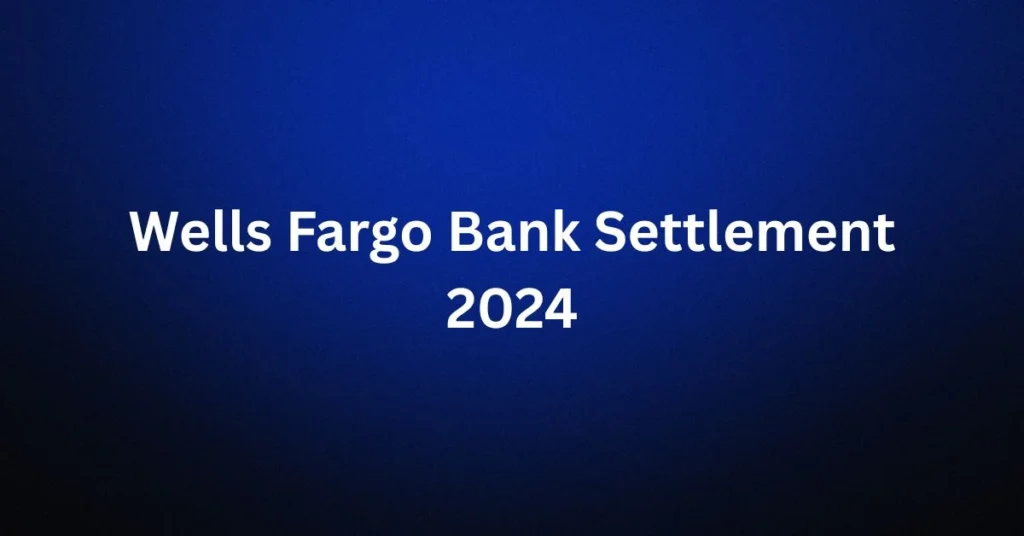In 2024, Wells Fargo entered a new phase of legal resolution that brings long-standing controversies closer to closure. This year has been marked by high-profile settlements that address customer harm related to mishandled mortgages, unauthorized actions, and violations of privacy laws. These settlements are part of Wells Fargo’s ongoing attempt to rebuild its public image, correct its internal systems, and re-establish trust with regulators and customers alike.
This article offers a thorough breakdown of the Wells Fargo 2024 settlement developments, including details of who is eligible, how to claim payouts, and what these moves mean for the financial sector. Whether you are a former or current customer, industry observer, or investor, understanding these developments can help you navigate the broader implications of one of America’s largest banks reckoning with its past.
A Troubled Past Comes Full Circle
Wells Fargo’s recent legal challenges are not isolated events—they are the consequence of over a decade of missteps and misconduct. Once considered one of the most stable and customer-friendly banks in the United States, Wells Fargo’s reputation began to deteriorate in the mid-2010s.
Most notably, the bank admitted to opening millions of unauthorized accounts in customers’ names, an action that sparked regulatory crackdowns and public outrage. In the years that followed, additional issues emerged, ranging from discriminatory lending practices to mishandling of customer information and services. What distinguishes the 2024 developments is not just the size of the settlements, but the scope of reforms that now accompany them.
Breakdown of the 2024 Settlements
1. Unauthorized Mortgage Forbearance Payout
One of the major components of Wells Fargo’s 2024 legal settlements involves its handling of mortgage forbearance during the COVID-19 pandemic. Many customers discovered that their mortgages had been placed into forbearance—pausing payment obligations—without their consent or even their knowledge.
While mortgage forbearance was a relief option extended under federal guidelines during the pandemic, it required clear, informed customer approval. In many cases, Wells Fargo failed to obtain that, affecting the credit profiles and financial decisions of countless homeowners. The 2024 settlement includes:
- Monetary compensation for affected customers
- Automatic payments in some cases
- A claim submission process for others requiring verification
- Revisions to the bank’s mortgage servicing protocols
This part of the settlement reflects the evolving legal expectations around consent and transparency in banking operations, especially during emergency relief periods.
2. Call Recording Without Consent
In a separate but significant settlement, Wells Fargo resolved allegations that it recorded telephone conversations with customers without proper disclosure or consent. This practice, which ran afoul of state-level privacy laws, especially in jurisdictions with stringent consent requirements, sparked multiple lawsuits.
The bank agreed to provide payouts to customers who were recorded without knowledge or permission. The structure of this settlement includes:
- Tiered compensation depending on the number of calls affected
- A formal claim submission process
- Internal reforms to ensure compliance with call monitoring laws
This issue struck a nerve because it speaks directly to consumer privacy and corporate accountability. Customers expect transparency in how their personal data is handled, and the settlement reinforces that such expectations are not just ethical—but legally enforceable.
3. Regulatory Relief and End of Asset Cap
Perhaps the most transformative development for Wells Fargo in 2024 came not from the courts, but from the Federal Reserve. For years, Wells Fargo operated under an asset cap—a rare and punitive restriction that limited the bank’s ability to grow its balance sheet beyond a specific threshold.
The asset cap was imposed as part of enforcement actions responding to past misconduct. It was intended to force Wells Fargo to prove its ability to manage risk and implement adequate internal controls. In 2024, following years of operational overhaul, the asset cap was lifted.
This change signals that regulators believe Wells Fargo has made substantial progress in:
- Strengthening compliance and risk management systems
- Overhauling executive leadership
- Instituting a cultural shift within the organization
It also means the bank is now free to grow through lending and investment activities that were previously limited. This has implications for the bank’s market positioning, its competitive strategy, and its ability to serve customers at scale.

The Broader Impact on Customers
For customers, these settlements offer more than financial redress. They represent a broader change in how Wells Fargo must operate and engage with the people who trust it with their money and personal data.
Customers who are eligible for payouts are being notified through official communications, but the impact extends beyond compensation:
- Internal reform means improved customer service standards
- Stronger legal compliance enhances customer protections
- Transparent communication helps restore trust
At a time when digital banking and remote transactions are increasing, the importance of responsible data handling and customer consent has never been higher.
Industry Implications: Wells Fargo Bank Settlement
These developments also send a message across the broader financial industry. Settlements of this size and visibility establish new standards for:
- Transparency in crisis response (e.g., pandemic relief programs)
- Consent-based communication and data recording
- Customer-centric risk management practices
Banks are being held to higher standards not only by regulators but by the public. Wells Fargo’s 2024 settlements show that large institutions must not only be efficient and profitable—they must also be ethical, compliant, and responsive.
Internal Reforms Underway: Wells Fargo Bank Settlement
To comply with legal obligations and restore customer confidence, Wells Fargo has initiated a wide-ranging internal reform strategy. These reforms include:
- The creation of a centralized risk and compliance division
- Leadership restructuring in customer service and lending departments
- Mandatory staff training on privacy, consent, and ethical conduct
- Enhanced technological systems to track and record customer preferences accurately
These reforms are not merely superficial—they are monitored under consent agreements that require third-party oversight and periodic public reporting. For the average customer, this means the bank’s day-to-day operations are being more closely scrutinized than ever before.
Rebuilding Trust: A Long Road Ahead
Despite these steps, rebuilding trust is not an overnight process. Public skepticism remains, especially among those who were directly affected. Wells Fargo will need to show—not just promise—consistency in its ethical behavior and customer-first approach.
Public perception is shaped by more than news headlines. It is shaped by everyday interactions: timely responses to complaints, clarity in financial products, and respect for privacy and choice. As Wells Fargo works to correct course, each customer interaction becomes a test of whether the institution has truly learned from its mistakes.
Looking Ahead: Wells Fargo Bank Settlement
2024 may be a turning point for Wells Fargo, but the road ahead remains complex. The lifting of the asset cap and the finalization of settlements free the bank to focus on growth, but this opportunity is tempered by high expectations.
Financial analysts will be watching to see whether the bank’s reformed systems can prevent future crises. Regulators will continue to assess the integrity of its operations. And customers will remember whether promises turned into results.
In the coming months and years, Wells Fargo’s story will no longer be about what it did wrong—but about how it recovered, adapted, and hopefully evolved.
Conclusion: Wells Fargo Bank Settlement
The Wells Fargo bank settlements of 2024 are more than just financial transactions—they are reflective of an institution trying to reckon with its past and reimagine its future. Through legal agreements, regulatory improvements, and customer-focused reforms, the bank has taken steps toward accountability and renewal.
For customers, this means potential compensation, improved service, and a safer banking environment. For the industry, it sets a precedent that financial institutions must go beyond apologies—they must take measurable action. Whether Wells Fargo will succeed in regaining long-term trust remains to be seen, but 2024 has laid the groundwork for what could be a genuine transformation.
FAQs: Wells Fargo Bank Settlement
1. Am I eligible for a Wells Fargo 2024 settlement payment?
You may be eligible if your mortgage was placed into forbearance without your consent or if your calls were recorded without proper disclosure. Notices are being sent to eligible individuals, and claim portals are open.
2. How much compensation can I expect to receive?
Compensation varies based on the type of settlement. Some customers may receive automatic payments, while others need to submit claims to qualify. Amounts depend on individual circumstances and the number of claimants.
3. Do I need a lawyer to participate in the settlement?
No. Most claims can be submitted online or by mail using a simplified form. Legal representation is not required, though you may consult a lawyer if you have specific concerns.
4. What steps has Wells Fargo taken to prevent future issues?
The bank has implemented major internal reforms, including compliance overhauls, new leadership structures, and enhanced customer protections to prevent a repeat of past issues.
5. Can I still bank safely with Wells Fargo?
Yes. While the bank’s past actions were troubling, current regulatory oversight and reforms have increased the security and transparency of its services. However, as with any financial institution, customers should remain informed and monitor their accounts.
For more information, click here.









